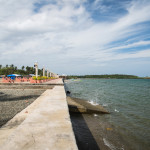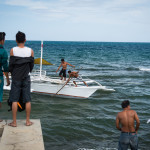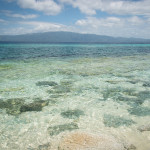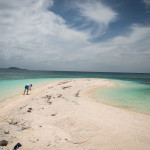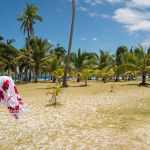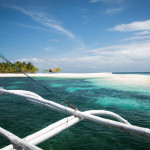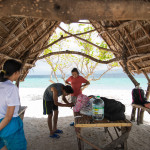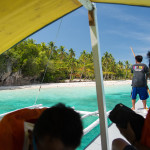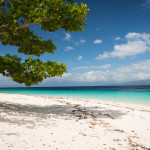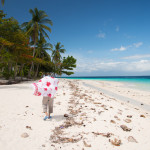I’ve got nine tickets to paradise
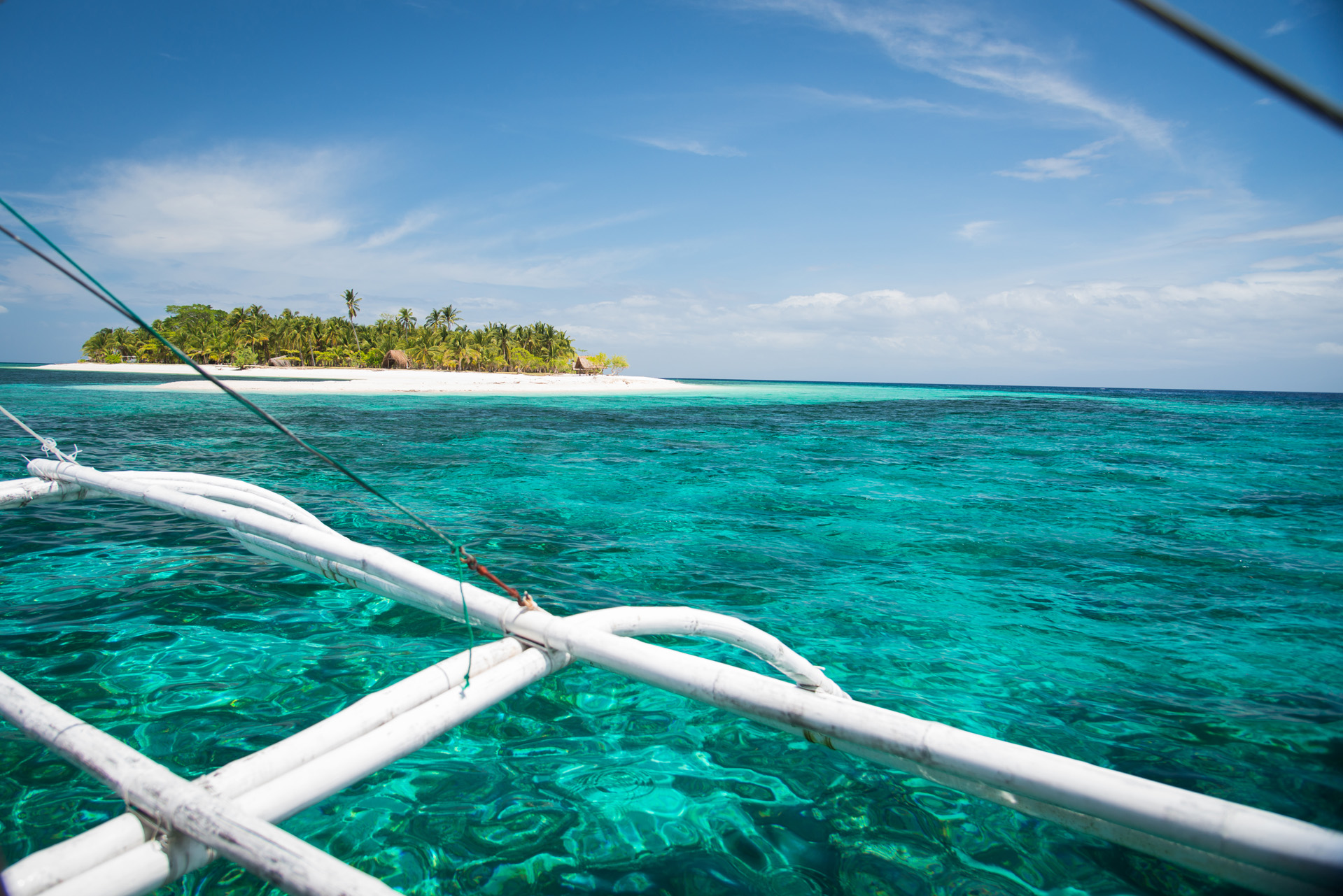
It’s funny how fast time flies when you’re having fun. I was originally planning on visiting a number of attractions in Leyte during my 6 day stint, but didn’t even come close to being able to do half of them. However, long before I set foot on Leyte I was adamant that no matter what happens, we MUST visit the Cuatro Islas. Located off the coast of Inopacan, a small coastal town about 20 minutes from Baybay; the Cuatro Islas are, as the name suggests, four islands sitting in the pristine waters of the Camotes Sea. You’ll not find these islands on any travel brochures or tourist agency itineraries; in fact, most of the information about them can only be found on the Internet or through word of mouth. As a result, the islands see very few visitors throughout the year so it’s very likely you’ll have the islands all to yourself should you dare to leave the comfort and safety of the mainland. And that’s just what we did.
Fortunately for us, the weather was cooperative all week so we were able to pick a day where there was no threat of rain and with only a calm breeze blowing.
- The staging point for boats
- The locals getting our boat to the ramp
- The clear waters of the Camotes Sea
- The tip of Digyo Island
- The cottage sitting in a sea of powdery sand
- Coconut trees of Digyo
I went island hopping in Palawan two years ago right after a huge storm hit Cagayan de Oro which lead to riding through wave after punishing wave and a total absence of sunlight; not exactly the kind of experience I wanted to replicate. Luckily for us two of the Siosons’ friends, Dionald and Junmar, already had experience traveling to the islands, so we relied on them to help make this trip happen; they left for the town of Inopacan well in advance to find us a ride. I had read from other blogs that the boats heading to the islands were fairly large and it’s preferable to go with a large group to get your money’s worth; after all, the boat rental will cost you the same kind of money if you were by yourself or if you were with a group of 16 and the Siosons definitely had enough friends to fill two boats. Unfortunately, since it was in the middle of the school year in addition to being the middle of the week, our party was a lot smaller than anticipated; only 9 people total made it for the trip. As small as our group may have been, nothing was going to stop us from getting to the islands.
Dionald and Junmar came through and called to inform us that they had nine tickets to paradise. We were ready at home just waiting for the word ‘Go’ and as soon as the call came in, we hurriedly made our way to Inopacan.
The drive was actually surprisingly easy, once we cleared Baybay’s busy downtown area it was a straight shot down a two lane road which goes through the heart of Inopacan. There we met up with our intrepid companions and headed for the bay walk area where the boats were waiting. Since it was weekday, the bay walk was pretty much empty and we were definitely the only people heading out to the islands that day. I’m really thankful for Dionald and Junmar for making the deal with the boatmen, since they appeared to speak mostly Visayan and often sounded like they were arguing with one another. The fare for a round trip to most popular island of the lot was P2500, an additional P500 was necessary if we wanted to visit the other 3 islands. Since it was my first time here, I chose to visit all of the islands; a bargain at P3000 ($67 bucks)! The boys did a great job of negotiating the fare; most people online were reporting between 3500 to 4500 for their trips and these were pre-Haiyan prices! If you have any local friends or contacts in the area, I strongly suggest asking them to help you with the boatmen so you can dodge any possible “special foreigner pricing”.
The pumpboat we chartered was similar to the ones I saw in Palawan and can probably seat 16 people easily, so we were able to move around and swap seats to our hearts’ content. We decided to head for Digyo Island first, since it was the smallest and most popular island. The trip to the island was mostly uneventful; the water was very calm The boat was mind-numbingly noisier than the ones I’ve been on and by the end of the 30 minute trip, it took at least 10 minutes before we could hear each other speak. None of that mattered though because as we began our final approach towards Digyo Island, we all sat there with mouth agape at the unspoiled splendor of this place.
The water was a crisp, crystalline blue that became more and more transparent as we got closer to shore where our feet met the pristine white sands of Digyo Island. Once our hearing finally adjusted to normal decibel levels, there was no loud music, no unintelligible chatter of bystanders, no sounds of modern technology; all we could hear was the gentle crashing of the waves and the sound of the wind as it caressed the leaves of the countless coconut trees that dotted the island. It was every bit as beautiful as the pictures and the blogs describe; it was in every sense of the word, paradise.
A huge part of the appeal of the Cuatro Islas is because of their untouched beauty; these are not highly developed resorts that have had millions of pesos invested in them to build luxurious lodging to attract wealthy foreign tourists, they are just as God had made them: perfect. You won’t find imported or bleached sand here, every grain is native to the islands and it has to be the cleanest sand I’ve ever seen. Being so close to nature has its own downsides, however, as you also won’t find running water, electricity, or food around here. Visitors are responsible for bringing their own supplies and cleaning up after themselves. A part of the reason why Digyo Island is the most popular out of the four is because it relatively has the most accommodations. There are cottages available for rent so you have a place for a meal as well as refuge from the sun and rain and I’ve even read that the caretakers provide a “rest room” for a fee somewhere on the island.
This makes Digyo the most viable for an overnight stay compared to the other islands. For providing some conveniences, the caretakers of Digyo Island do charge an entrance fee of P20 per head and renting a cottage will cost you P200; a reasonable price for much needed provisions.
The water around Digyo Island was surprisingly cooler than I had anticipated, maybe because our bodies were already pretty warm from the searing sun, but that didn’t deter us from jumping right in! The sand bed was covered with pieces of old, dead coral and was difficult to walk around in barefooted; luckily for me I had strappy velcro sandals so I was able to keep them on while playing in the water, but the others weren’t so lucky. I’m not much of a swimmer so me and Lormi just frolicked around in waist deep water, looking for the areas where the ocean was slightly warmer. After getting our fill of the ocean, we retreated to the shade of the cottage where we had our lunch. There we were joined by some of the four legged residents of the island, who were gave us their best puppy dog faces in an attempt to guilt us into dropping some food their way. They failed miserably, but fortunately they didn’t seem to mind and just continued to hang out in our cottage. Once lunch was out of the way, we all decided to walk around the island and collect some shells while we were at it. Digyo Island is tiny, so it really only takes 10-15 minutes to circle, but it’s worth to make the walk just to see the various facets of the island, from the rocky opposite end of the white sandy beach, the numerous coconut trees or the weird, pineapple-like fruit that grows on the island (I later found out they were Pandan fruit!).
When we made our way back to our starting point, we decided to take one last swim in the inviting waters before heading out to see the other islands. We were informed by the boatmen that two of the islands were populated and the beaches weren’t as spectacular as the ones on Digyo. Since we wanted to be back home before sunset, we decided to pass on stopping by. Those two islands were Apit and Himokilan, both have small settlements originally started by fishermen some time ago. Apit Island is the most populated of the two, houses and buildings sit really close to the shore so it was evident that more than a few people lived on the island. Next time around, I would definitely like to visit these islands and maybe even find out how I can have a place of my own there someday 😉
Our last stop of the day was Mahaba Island, the second largest island of the family in terms of land mass and may very well be my favorite island. Unlike Digyo, Mahaba is bordered mostly by rock formations but the one lone beach that it does have was well worth the visit. It may be hard to believe, but Mahaba’s beach is probably even better than Digyo’s; unlike Digyo, the sand bed on the shore is relatively free of crushed corals and rocks making it much easier to walk on. There may not be any cottages to rent, but rest assured there are plenty of coconut trees lining the beach to provide shade and the grassy areas make for an incredible spot for picnics or afternoon siestas. I only wished that we could have stayed longer to explore more of the island while enjoying the soft breeze, but time really does fly when you’re having fun. Unfortunately for us, the winds had begun to pick up on our way back to Inopacan and the sea became restless. The boat had crested a number of large waves which repeatedly splashed those of us sitting in front of the boat. It made for a more exciting ride, however, once that that salt water gets in your eyes it’s considerably less fun! We eventually made it safely back to Inopacan where I paid the boatman his dues. On the ride back to Baybay, we couldn’t stop talking about our island experience and already began contemplating when we would return. An overnight stay is definitely going to be in our future; I get giddy with anticipation at how incredible the sights and sounds must be on an island so far away from civilization.
One note of caution, particularly to foreigners: be sure to apply plenty of sunscreen on all exposed skin and do it often! I made the huge mistake of not putting on any sunscreen on my legs or the back of my neck and while I didn’t immediately feel my skin crisping up like bacon on a hot griddle, I definitely felt the effects the following day. The Philippines is located much closer to the equator which means the sun’s rays are considerably more intense, so don’t make the assumption that won’t get sunburned! Not only did I get a nasty farmer’s tan, but my skin became so red and tender than even the lightest touch became ridiculously painful. I don’t regret a thing though, our time in the islands was priceless and I would have braved jellyfish stings and dehydration to spend another hour there!
Some may find it a turnoff to spend so much time and effort in a place where there isn’t even a bathroom, but that’s exactly what drew me here. I don’t like touristy places, I don’t like crowds, and I don’t like have to overpay for a bunch of luxuries that I could care less for. There are no ‘peak’ seasons so you don’t need to call ahead, you don’t need a reservation and you don’t need to book with a travel agent. The Cuatro Islas are a perfect example of how less is really more and how stunning simplicity can be. I’ve been to beaches and resorts in Cebu and Palawan and none have left me with the same sense of wonderment and delight as the Cuatro Islas.
My only hope is that the islands remain as they are for many more years to come, so that people can continue to enjoy the pleasure that only mother nature can provide. If you ever find yourself on these islands, do us all a favor and have fun, but don’t forget to clean up after yourself!

